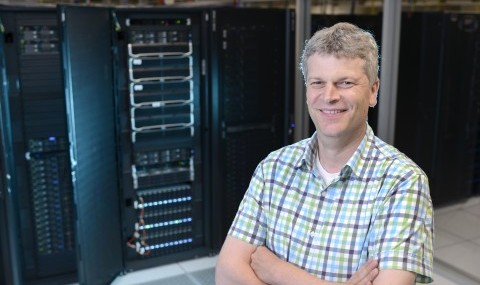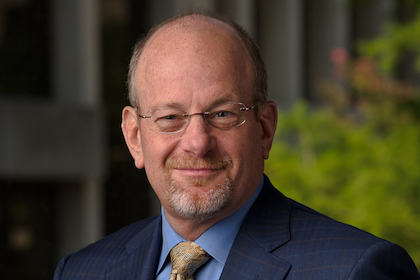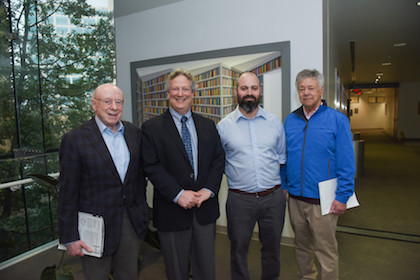New Bioinformatics Department to bridge research and clinical care

UT Southwestern Medical Center has established the Lyda Hill Department of Bioinformatics to drive innovation in new information technology to help researchers and clinicians on campus and beyond address scientific and medical challenges.
The Chairman of the new Department is Dr. Gaudenz Danuser, Professor of Bioinformatics who also is a Cancer Prevention and Research Institute of Texas (CPRIT) Scholar. Before joining the UT Southwestern faculty in 2013, he directed research laboratories at ETH Zurich, at The Scripps Research Institute in La Jolla, Calif., and at Harvard Medical School. Dr. Danuser received his Ph.D. from ETH Zurich in Switzerland in electrical engineering and computer science, both with distinction.
Center Times recently spoke with Dr. Danuser about bioinformatics and his plans for the new Department.
Bioinformatics has been identified as one of the most important disciplines for scientific growth at UT Southwestern. What is the role of bioinformatics in academic medicine?
The term bioinformatics was coined in the 1970s by the Dutch mathematician Paulien Hogeweg as the ‘theory and implementation of computational methods that recognize patterns in biological data.’ According to this original definition, we can think of bioinformatics as the science of pattern recognition in any biological or biomedical data set.
Most people, however, will associate bioinformatics with genomic data analysis – using computer algorithms, or sets of detailed instructions, to find mutations in genes and match up mutations between patients or between cells.
We absolutely will generate technology to process genomic information. But I want to take bioinformatics beyond this, and use bioinformatics as the computer science of data integration across all biomedical disciplines.
Each discipline is becoming overwhelmed with data that cannot be analyzed by the human brain alone. Being able to process this data with modern computational approaches will allow us to address important questions in basic research, population studies, and clinical care and will help us advance our ability to prevent, detect, and treat disease.
Can you give some examples of how bioinformatics will be used?
There is a whole field of computer science that seeks to optimize treatment strategies through the use of mathematical calculations. For example, by integrating data from other medical centers around the country and the world, we can use computers to identify correlations between patient conditions, treatments, and outcomes, and derive the best strategy for caring for a patient here in Dallas. In the not-so-distant future, medical doctors will be presented with a panel of computationally optimized treatment plans with their projected likelihood of success. This will be very powerful support for clinical decision-making and it has the potential to massively reduce the cost of treatments.
What is driving the increasing interest in bioinformatics?
As time goes on, each biomedical discipline will get better technologies to acquire complex data. And while the human brain is fantastic in organizing information at a conceptual level, we are really overwhelmed with the masses of data that can be generated today. So we need computers to extract the information in useful ways. Many on campus are asking for that type of data integration and analysis.
Some of the most exciting research in this area is happening in the private sector. We will be competing for talent, for example, with companies like Google, Facebook, or Amazon. They all use and develop extremely sophisticated pattern recognition methods to run their businesses. And because of this competence, some of these companies are directly entering the health and life sciences market. It will be interesting – and challenging for us – to define the roles of an academic medical center in this rapidly growing era of information technology.
What areas on campus will your Department support?
The Lyda Hill Department of Bioinformatics is designed to become a shared resource – a department of integration – working with all research and clinical departments in one way or another. Increasingly, medical doctors are becoming users of information processing systems, and because of information technology, the distance between basic research and clinical practice is getting shorter. We want to help drive this transition at UT Southwestern.
The long-term impact we really want to have is that in 30 years, there will be algorithms running in medical centers around the world that were developed at UT Southwestern. And we want to create spinoff companies whose products shape medical practice in a variety of settings.
What are some of the educational goals of your Department?
We are building a computer science department in the medical school and will take a leading role in establishing an internationally recognized graduate program and postdoctoral training program. We want to create a unique training environment at UT Southwestern for computer science and math students who wish to contribute with their analytical skills to initiatives that augment human health. The graduate program, of course, will also enable us to grow analytical talent for our own campus to maintain our status among the top medical schools nationally and worldwide.
What types of staff positions are you recruiting to build the Department?
We have an ambitious recruitment plan. Our target is to bring on 16 faculty members in the next 10 years, in addition to filling staff positions in computer and data science. The plan is that about half of the faculty recruits will have joint appointments in other departments.
Bioinformatics is an incredibly competitive marketplace. I need the campus’s help and will enlist my clinical and basic science colleagues to work with us to convince those we are trying to recruit that UT Southwestern is where they should be – to make Dallas and UT Southwestern the workplace for them.
We will run this Department with the spirit of a high-tech startup company. No hierarchy, but instead a lot of self-motivation and excitement – and, yes, I am working on getting a foosball table. The Department will be located in an open office space on the 4th floor of the E Building, which is the old library building on South Campus. Some faculty, like me, will have their labs in other department spaces. This will foster immediate interaction and integration.
Dallas philanthropist Lyda Hill gave $25 million to establish the new Bioinformatics Department. What are your thoughts about such extraordinary support?
We are all very grateful to Miss Hill. I find it really amazing that our donors, including Miss Hill, give money to science that is not going to generate a return on investment immediately, but will provide a much bigger return on that investment later on. We hope that we will have a very quick turnaround in bioinformatics for the campus, but it’s clear that the real fruit of the effort we’re now starting is going to come in 10, 15, or 20 years.
For someone to step in and say, “this is worth $25 million” is just fabulous.
You have held distinguished roles in laboratories in Zurich, Switzerland, as well as Scripps Research Institute and Harvard Medical School. What attracted you to UT Southwestern?
The original impetus was for me to become a cancer cell biologist. I have been a computer scientist, and after my postdoc training, I began to apply computer science to study cells.
I was recruited through the Cancer Prevention and Research Institute of Texas. The CPRIT investment gave me the opportunity to build a completely new lab structure. For the first time in my career, I have a lab where we integrate molecular cell biology, imaging, and computer science all in a homegrown manner, tailored to specific research questions we want to address.
My own research program requires an environment where computer science is celebrated. And with the new Lyda Hill Department of Bioinformatics at UT Southwestern, I have an opportunity now to help build a computer science community that will do important things beyond my own immediate interests. So, I’m very excited to be here and to learn together with a growing Department about all the incredible innovations we can accomplish for biomedical research based on computer science.
###
Dr. Danuser holds the Patrick E. Haggerty Distinguished Chair in Basic Biomedical Science.



